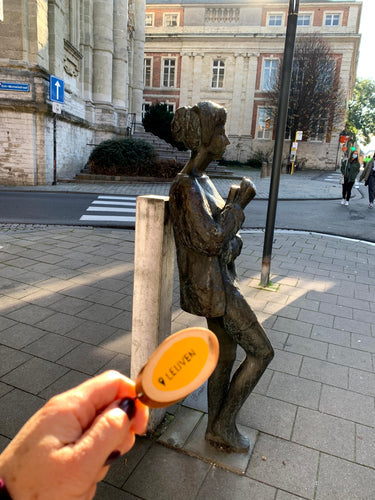In the heart of Leuven, on Naamsestraat, stands a remarkable statue with a compelling story. The Renée statue was gifted to the city in 1997 by the Trade Association of Leuven to celebrate its 50th anniversary. More than just a piece of art, Renée symbolizes the determination and diligence of Leuven's female students.
A Contrast to Fonske
Renée is often seen as the opposite of Fonske, another well-known sculptor in Leuven. While Fonske represents the lighthearted, fun-loving student, Renée embodies the hardworking, ambitious female student—a tribute to the academic dedication of young women in Leuven.

Renée Statue in Leuven: A Tribute to Hardworking Female Students
In the heart of Leuven, on Naamsestraat, stands a remarkable statue with a compelling story. The Renée statue was gifted to the city in 1997 by the Trade Association of Leuven in celebration of its 50th anniversary. More than just a piece of art, Renée symbolizes the determination and diligence of Leuven's female students.
A Contrast to Fonske
Renée is often seen as the opposite of Fonske, another well-known sculpture in Leuven. While Fonske represents the lighthearted, fun-loving student, Renée embodies the hardworking, ambitious female student—a tribute to the academic dedication of young women in Leuven.
A Historical Location with Deep Meaning
Renée is strategically plocatednear Utrecht College, a historically significant institution. thatwas the first to offer university degrees in teaching to women in 1921. The statue is also named after René Depret, a prominent figure in Leuven who led the Merchants Association of Leuven and the Friends of Leuven Museums.
Symbolism Behind the Statue
The book in Renée's hands is titled ‘Loveniers Armand’, which is the name of the sculptor, a subtle artistic signature.
Her placement on Naamsestraat is not random—this street is the beating heart of KU Leuven. Home to the university halls, administrative offices, and historic colleges, Naamsestraat has been a hub of education for centuries. Nearby is the first girls’ pedagogy of KU Leuven (1921-1977), housed in Utrecht College (Arras College), which was originally founded in 1508 as a college for poor students.
In the courtyard of Utrecht College, an ancient Japanese honey tree, known as “the tree of great sorrow,” still stands. The name comes from the tradition where students had to bid farewell to their sweethearts every evening. This adds a nostalgic layer to Renée's presence—an indirect reminder of love stories from Leuven's past and present.
A Modern Reflection of Academic Confidence
Though Renée may evoke echoes of past love stories, her stance tells a different tale. Dressed in a miniskirt, she stands elegantly with one leg slightly bent, exuding confidence. Clutching her books firmly, she appears ready for her exams and determined to succeed. Some might even call her "the waiting one," as she stands poised for whatever comes next—a symbol of ambition and resilience.
The Renée statue is more than an artistic landmark in Leuven; it is a symbol of progress, education, and female empowerment. As she stands proudly in the historic university district, Renée continues to inspire students—past, present, and future—to confidently pursue their dreams.
Products we created for you are inspired by sculpture.

(Source: http://2020group1.onlinepublishing.ulyssis.be/renee , Leuven Gebeiteld_metkaft - Leuven statues.pdf, and A guide to the statues of Leuven.pdf)
Photo by Aslı Tezcan



